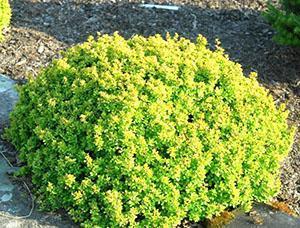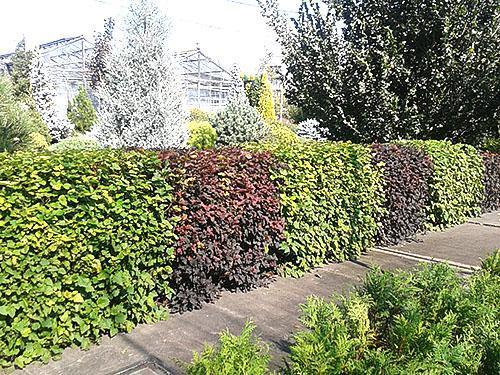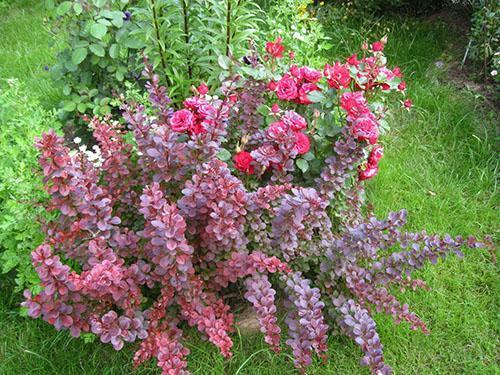Amazing beauty barberry shrub in your garden
 Barberry shrubs are popular among landscape designers for their bright, elegant foliage and beautiful fruits. With their help, it is possible to create unusual compositions and turn a simple courtyard into a corner of paradise.
Barberry shrubs are popular among landscape designers for their bright, elegant foliage and beautiful fruits. With their help, it is possible to create unusual compositions and turn a simple courtyard into a corner of paradise.
How to choose a barberry shrub for the garden
Today there are about 200 varieties of this plant. They differ among themselves not only in the color of the leaves, but also in the strength of growth, shape and purpose. Before planting this plant on your site, you need to find answers to the following questions: how to grow barberry, which variety is suitable for your region, which plant shape will look beautiful on the site or in the garden?

Before buying the desired variety, you first need to look at the photo of a barberry shrub in adult form, choose the desired color, size and only then go to the market or store.
Breeding secrets of barberry
 You can find a lot of useful information about the methods of breeding barberry, but several of the most popular among amateur gardeners and professionals should be highlighted:
You can find a lot of useful information about the methods of breeding barberry, but several of the most popular among amateur gardeners and professionals should be highlighted:
- Cuttings.
- Seed reproduction
- Reproduction by layering.
- Division of the bush.
Each method is characteristic in that it is applied at a certain time of the year. For propagation by cuttings, young, mature branches are cut in mid-August. The cut branches are rooted and planted in loose, moist soil. If a dry autumn is foreseen, then planting is better done in a greenhouse or a small greenhouse, which will control humidity and protect the cutting from sudden cold snaps at night. A closed room must be ventilated every day and avoid excess moisture. It is also important to loosen the soil and remove weeds once a week.
 It will take a lot of patience and knowledge to grow barberry from seeds, but these plants will be strong and resistant to climatic conditions. Sowing works are carried out in autumn. First you need to collect mature seeds from strong and beautiful plants, separate the seed and rinse it under running water. The seed-seed is dried and only then sown in a container with soilwhich consists of sand and peat (1: 1). A box with bones is buried in the ground and left there until spring. The seeds are stratified and in spring they give amicable shoots.
It will take a lot of patience and knowledge to grow barberry from seeds, but these plants will be strong and resistant to climatic conditions. Sowing works are carried out in autumn. First you need to collect mature seeds from strong and beautiful plants, separate the seed and rinse it under running water. The seed-seed is dried and only then sown in a container with soilwhich consists of sand and peat (1: 1). A box with bones is buried in the ground and left there until spring. The seeds are stratified and in spring they give amicable shoots.
With spring sowing, seed germination will not be high and most seeds will germinate only the next year.
For the seeds to successfully pass stratification, you can place the box with crops in a cool, dark room, but then the humidity and temperature should be controlled (not lower than -1). In early September, the strongest plants are chosen and planted in the garden. In the spring, next year, strong seedlings can be transferred to a permanent place, and weak ones can be left for autumn planting. Such plants bear fruit in three years, after the emergence of shoots.
 Reproduction by layering is the easiest way that even inexperienced gardeners can do. A large percentage of rooting during propagation by layering falls in the spring. For the procedure, you should choose young, completely unripe branches and evenly place them in the grooves dug near the trunk circle. The branches are fixed with wire brackets, the grooves are moistened and covered with earth, leaving the top of the shoot above the ground. In early September, rooted branches will form a lush root system. They can be separated from the mother plant and planted in a permanent place. Such a plant will bear fruit the next year.
Reproduction by layering is the easiest way that even inexperienced gardeners can do. A large percentage of rooting during propagation by layering falls in the spring. For the procedure, you should choose young, completely unripe branches and evenly place them in the grooves dug near the trunk circle. The branches are fixed with wire brackets, the grooves are moistened and covered with earth, leaving the top of the shoot above the ground. In early September, rooted branches will form a lush root system. They can be separated from the mother plant and planted in a permanent place. Such a plant will bear fruit the next year.
 They resort to dividing the bush if the plant has grown and it is necessary to limit its habitat. You can carry out the procedure at any time. To avoid stress for the plant and not to lose the harvest, it is better to do this in early spring (early March) or late autumn, after leaf fall. The mother bush must be dug from all sides in order to cover the bulk of the horses. After digging, the bush is sawn with a saw into several parts so as to capture the roots for each plant. The depth of each planting hole must be at least 0.5 m.
They resort to dividing the bush if the plant has grown and it is necessary to limit its habitat. You can carry out the procedure at any time. To avoid stress for the plant and not to lose the harvest, it is better to do this in early spring (early March) or late autumn, after leaf fall. The mother bush must be dug from all sides in order to cover the bulk of the horses. After digging, the bush is sawn with a saw into several parts so as to capture the roots for each plant. The depth of each planting hole must be at least 0.5 m.
Each planting pit must be equipped with a drainage system. This will protect the plants from waterlogging and help the root system quickly take root in a new place.
After planting, the plants are covered with soil. Watered and tamped the earth tightly in the near-trunk circle so that it tightly grabbed the roots.
Barberry: growing and care
 Many beginner gardeners are wondering how to plant a barberry correctly so that it quickly takes root and pleases with a rich harvest. This is not difficult to achieve if you follow the recommendations for growing and planting barberry:
Many beginner gardeners are wondering how to plant a barberry correctly so that it quickly takes root and pleases with a rich harvest. This is not difficult to achieve if you follow the recommendations for growing and planting barberry:
- Barberry prefers soil with normal acidity. If the acidity of the soil is higher than 7 PH, then it must be treated with lime. It is quite simple to do this: add about 300 g of slaked lime or a glass to the pit when planting wood ash... It is important that the ash is from sheet wood. Ash from oak wood cannot be added.
- After the spring division of the bush or transplant, it is necessary to water the first two months and during the summer heat.
- Barberry prefers bright places, but grows well in the shade. Varieties with bright colored leaves in the shade lose their decorative effect.
- To form a beautiful hedge, it is necessary to plant bushes at the rate of two plants per 1 m.
- It is desirable to feed the plants at the root once a year (in spring).
- Frequent loosening is the key to a good root system and spreading branches.
- Mulching will help retain moisture in the trunk circle in summer.
- Regular pruning of barberry bushes will help maintain the beautiful aesthetic appearance of the plant.
Growing barberry and caring for it must be carried out in accordance with the instructions received, so that the shrub will delight with its bright foliage and toy fruits.
Hello. Please help to form the front garden in front of the house. Size 10x3 m, east side, flat surface. I have 2 small thuja 50 and 45 cm, though I'm not familiar with the variety (pictured). I would very much like to plant more euonymus, spirea and junipers, possibly hosts. What varieties would you recommend? At what distance from each other and from the blind area of the house should plants be planted? Should you add annuals (asters, sunflowers, marigolds) or perennials (eg peonies). What landing patterns can you suggest? I am grateful in advance, I really hope for your professional help.
There are a lot of front garden planting schemes. There is no point in giving recommendations without looking at your site. It is necessary to take into account absolutely everything - the composition of the soil. the location of the front garden.groundwater level First, decide. what would you like to see. Next, check your chosen plants for compatibility.